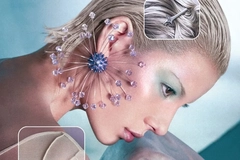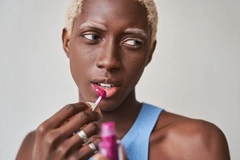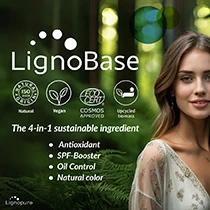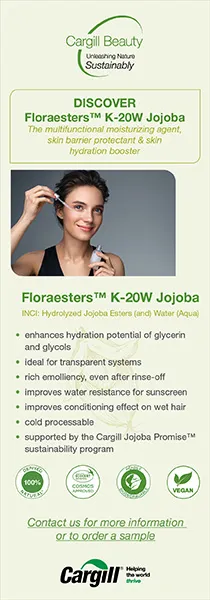Cosmetics safety assessment of Rosa canina for skincare and makeup, expert panel flags potential risk
.jpeg)
13 May 2022 --- A safety review into 12 Rosa canina-derived ingredients concludes they are safe in current uses when formulated to be non-irritating and non-sensitizing.
However, the US-based Expert Panel for Cosmetic Ingredient Safety (panel) flagged that since final product formulations can include multiple botanicals containing the exact constituents of concerns, formulators should be aware and avoid reaching culminating levels that may be “hazardous” to users.
Additionally, the panel found various cosmetic properties within Rosa canina-derived ingredients. Different types offer benefits such as skin conditioning, fragrance, cosmetic astringent, anti-acne, abrasive, humectant and exfoliant functions.
Rosa canina is also known as dog rose – a herb belonging to the Rosaceae family, and is among the plants growing in Northeastern Portugal and the Hadim, Taskent and Ermenek regions of Turkey.
Multi-functional properties of Rosa canina
The ingredients tested include Rosa canina fruit extract, Rosa canina bud extract and Rosa canina leaf extract containing skin-conditioning agents.  Formulators should be aware and avoid reaching culminating levels of Rosa canina that may be “hazardous” to users.
Formulators should be aware and avoid reaching culminating levels of Rosa canina that may be “hazardous” to users.
Rosa canina fruit, also known as rosehip, Rosa canina fruit juice and Rosa canina flower extract, was found to have cosmetic astringents.
Additionally, Rosa canina flower contains fragrance ingredients along with Rosa canina flower oil which also contains skin-conditioning and emollient agents.
Abrasives and skin-conditioning agents were found in Rosa canina seed. Rosa canina seed powder also contained abrasives and exfoliants.
While anti-acne and skin-conditioning agents were found in Rosa canina flower powder, humectants, skin-conditioning, and emollient agents were found in Rosa canina seed extract.
Lastly, fragrance ingredients, skin-conditioning and emollient agents were found in Rosa canina flower oil.
Hair, skin and lip application limits
The panel suggests that cosmetic products containing Rosa canina-derived ingredients may be applied to the skin and hair or eyes. However, the Rosa canina fruit extract should only be used up to a maximum of 0.2% in eye area cosmetics as it may come in contact with the eyes.  Various skin conditioning, fragrance, cosmetic astringent, anti-acne, abrasive, humectant and exfoliant functions can be derived from Rosa canina.
Various skin conditioning, fragrance, cosmetic astringent, anti-acne, abrasive, humectant and exfoliant functions can be derived from Rosa canina.
There should also be limited exposure to mucous membranes, maximum of 1.5% in lipstick containing Rosa canina seed extract.
However, the panel nuances the concentration levels by accounting that some products are reused daily, like lipsticks which are reapplied multiple times a day and extend over many years.
“Some of these ingredients are being used in products that may result in incidental ingestion. For example, Rosa canina seed extract is being used in lipstick at maximum use concentrations up to 1.5%, Rosa canina flower extract is being used in lipstick at maximum use concentrations up to 0.04%, and Rosa canina fruit extract is being used in lipstick at maximum use concentrations up to 0.0015%,” shares the panel.
Rosa canina flower extract is currently used in pump hair sprays at maximum use concentrations up to 0.001% and perfumes at maximum use concentrations up to 0.01%.
Rosa canina fruit extract is used in powders (dusting and talcum) at maximum use concentrations up to 0.01% and in face powders at maximum use concentrations up to 0.002%, share the panel.
Skin pigment and non-irritant tests
The panel carried out a test on brown guinea pigs whose skin was UVB-induced for pigmentation. They found that pigmentation was reduced after dosing with Rosa canina fruit extract.
“Thus, the oral administration of Rosa canina fruit extract to brown guinea pigs caused inhibition of skin pigmentation. Proanthocyanidins in Rosa canina fruit extract was found to be the active principle responsible for the inhibitory effect on the pigmentation of guinea pig skin.” There should also be limited exposure to mucous membranes.
There should also be limited exposure to mucous membranes.
However, the panel notes that in another in-vitro study, “proanthocyanidins from grape seeds did not affect the expression of tyrosinase protein in normal human melanocytes.”
Additional studies confirmed that Rosa canina flower extract in lip balms did not have skin irritation or sensitization potential. When applying Rosa canina fruit extract, the product was classified as non-irritating on the skin.
“According to the FDA, rose fruit (hips) is generally recognized as safe for use in food for human consumption. In traditional folk medicine, the petals, fruit, and leaves of Rosa canina are used in the treatment of various diseases/conditions, such as nephritis, common cold, flu, coughing, bronchitis, eczema, itching, and biliary diseases,” notes the panel.
“Rosa Canina fruit contains many bioactive compounds, including GOPO, vitamin C, phenolics, lycopene, lutein, zeaxanthin, and other carotenoids.”
Metal trace impurities
In the impurity analysis of Rosa canina fruit extract, there were no traces of cadmium, chromium, cobalt, mercury, and vanadium. However, traces of antimony, arsenic, nickel, lead and selenium was found, whereas “less than two ppm of heavy metals were reported.”
“According to another source, Rosa canina fruit extract (ethanol extract or butylene glycol extract) contains heavy metals (not more than 20 ppm) and arsenic (not more than two ppm),” shares the panel.
Edited by Venya Patel












